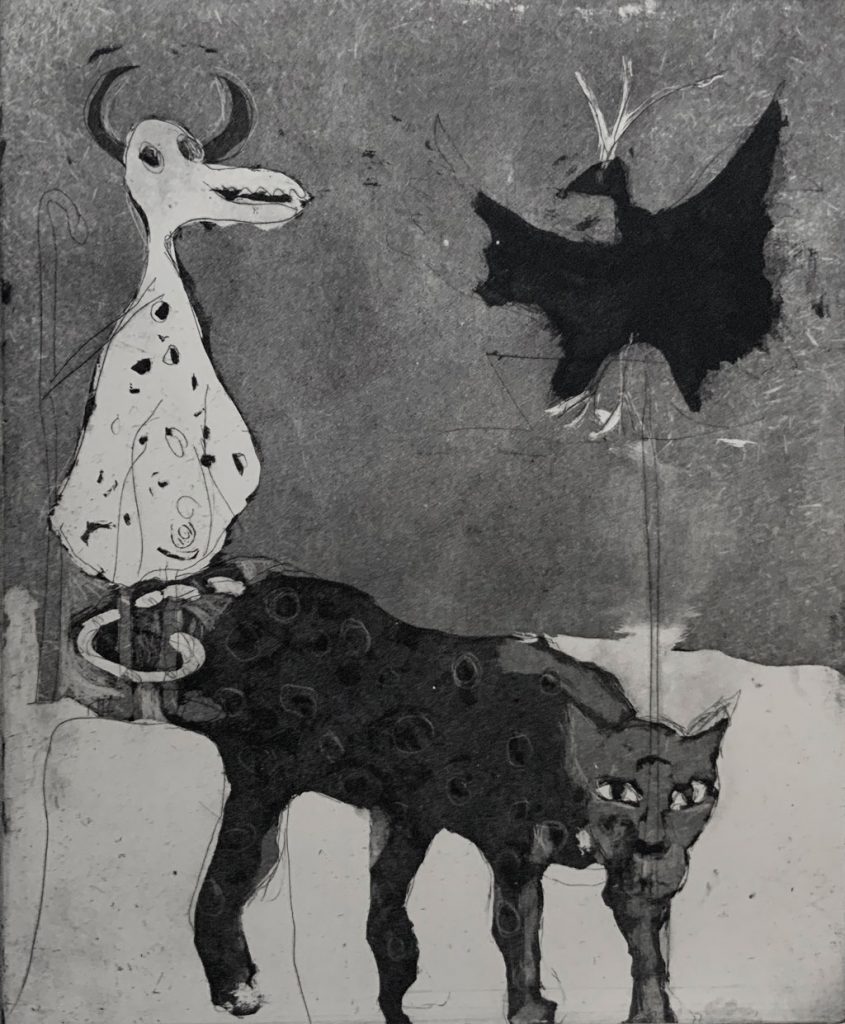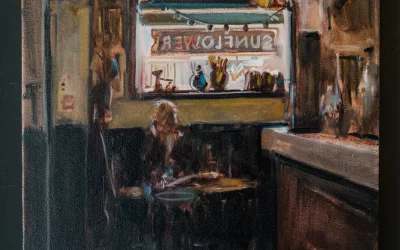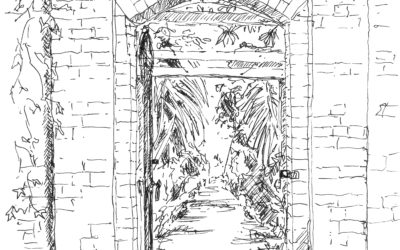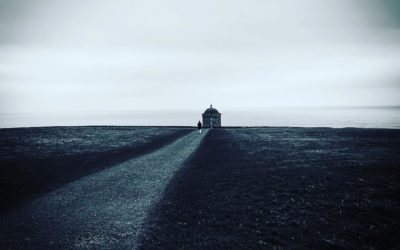First published in the VAN (Visual Artists News Sheet), 27 June 2019.
‘A Harlot’s Progress’ refers to William Hogarth’s series of the same name – a moral tale of the short life of one Moll Hackabout, who travels from the countryside to London, falls into prostitution, and succumbs to syphilis and death. Artist Karen Daye-Hutchinson’s interpretation of the sequence goes beyond the scope of Hogarth, not only in comprising 12 etchings (as opposed to Hogarth’s six engravings), but also via a prologue in which we learn the motivations of the young woman to leave her ‘shit hole’ of a village and seek her fortune in the big city by following her father’s suggestion (and against the will of a ‘disapproving mother’) to attend art college.
In Where you came from, our young protagonist stands awkwardly in a dark space of her own – a foreshadowing of the slab she will later lie on. Buildings loom in the background – one pencil-like (a reference to art college?) and turreted like Rapunzel’s or St Barbara’s tower. Is the horse her mode of transport (as with Hackabout), or a reference to the village, or a symbol of her father next to a Guernica-like face in profile which strains to follow her, the mother perhaps?
Leopard on a pedestal features the eponymous large cat, next to what appears to be a Dyson ‘pedestal fan’. Posed odalisque-like on the floor is our writhing protagonist, seemingly entranced by the lures of the metropolis. The horse and floating face observe in silence. The marriage sees her dressed in a simple white gown and oversized shoes beside the ghostly figure of the groom. On the left, an ominous black bird with splayed wings perches above a tasselled rug with a snake pattern. The presence of man, woman and snake is like the premonition of the fall from grace.
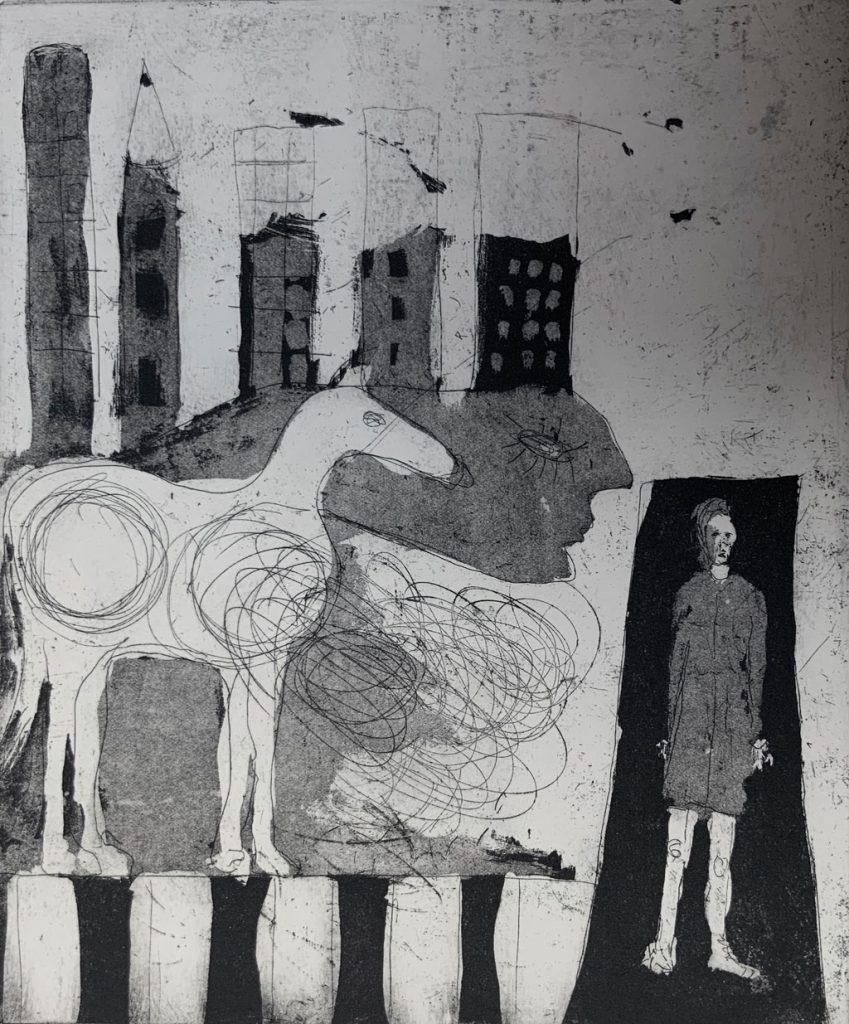
Karen Daye-Hutchinson, Where you came from, artist proof 36 × 31 cm; courtesy of the artist and ArtisAnn Gallery
In Under the spotlight, the heroine is sexier and more confident, reclining with a drink in her right hand. A child-like silhouette on the floor unsettles the harshly lit scene. Without volume it is like a stain, or a miscarriage, a shed skin, or the artist herself. On a pig’s back recalls the dog in Hogarth’s Bridewell Prison scene, or the decadence of Rops’ ‘Pornokratès’. The Orgy features, we assume, the husband and wife from plate four, sharing a bath with a bloated grinning hyena and a pale diaphanous female figure. The outline of the bath passes unobstructed through both of these figures: they are transparent, illusory or symbolic. In The wicked: they wait, malevolent creatures seem poised to attack.
The hyena returns in The onlookers, accompanied by another in the shadows. The animals are beautifully executed – the artist applying a tone using aquatint, and then burnishing it back to create soft chalky lines. In The cat and the blackbird, a white figure lies Marat-like on the ground in an ambiguous eyrie-like space, watched over by a white cat and a black bird. In The ascension, the blackbird is now a dove taking flight – the conjunction of both birds reminiscent of Delargy’s Beckett series. A head (or two?) emerges from a flickering bonfire, while a shadowy angel conjures the apparition from the flames or simply warms his hands beside the fire. The background is a gorgeous velvet black speckled with stars where the artist has perhaps applied a hand-shaken aquatint or spattered the area with stop-out varnish.
As with Horgarth’s final scene, The beginning or the end has a cyclical quality to it. We seem to be back in the countryside of the prologue or the afterlife. But this is no ‘shit hole’; rather a bucolic landscape with the heroine reclining under a tree, in Moll’s hat and nuzzled by sheep. The father and mother figures reappear but seem softened.
From Joyce to Atwood or indeed David Hockney – who interpreted Hogarth’s ‘A Rake’s Progress’ (recently exhibited in Belfast) – the use of a prototype source has been employed by the artist as a framework for inspiration. Although conceived in the same spirit, with similar use of animals as symbols, snippets of text, and biblical and contemporary references, Daye-Hutchinson’s suite of works is not a modern retelling. Her print cycle is more elliptical, steeped in mood and symbolism, and she shows compassion towards her young heroine. There is much to take in here. Like Hogarth’s, the prints ask to be read; yet their meanings can never be pinned down. In terms of technique, the works are a masterclass in printmaking, with a balance between premeditation and spontaneity. The catalogue urges viewers to consider each print as a complete work in its own right; however, to only view the pieces in isolation would deny us of the subtle interplay and enduring impact they achieve as a whole.
Jonathan Brennan is a multidisciplinary artist based in Belfast.
jonathanbrennanart.com
Featured Image
Karen Daye-Hutchinson, The wicked – they wait, artist proof 36 × 31 cm; courtesy of the artist and ArtisAnn Gallery

